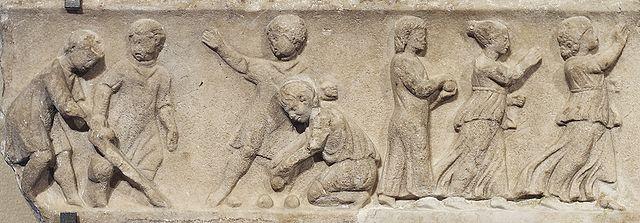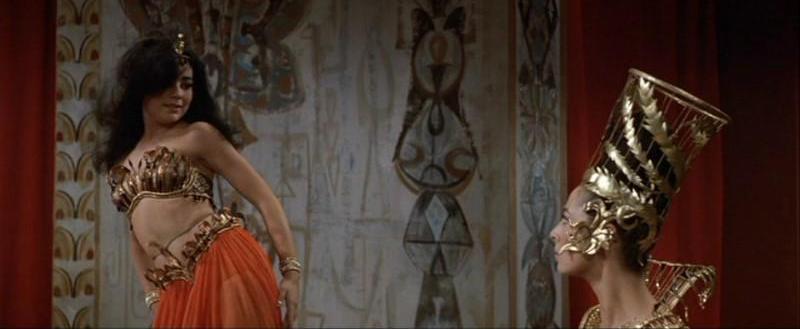
Children playing ball games. 2nd century AD marble relief, probably Roman. (Source: Wikimedia)
You are viewing: How Old Was Salome When She Danced For Herod
Most people think of Salome as a conniving, dangerous seductress, but is her reputation as a seductress deserved? In this post, I look at the daughter of Herodias who “danced” for Herod Antipas in order to discover what kind of person she was and to find out what she did that resulted in John the Baptizer being beheaded.
[An article on Salome who was a follower of Jesus is here.]
Preamble: Young Woman or Little Girl?
I was reading 1 Samuel chapter 9 today, in the Greek, and I came across a word that is translated in 1 Samuel 9:11 (NIV) as “young women.” The word is korasia (plural).[1] When I think of “young women” I think of women around the ages of 18-25, but the “young women” in 1 Samuel 9 were probably girls whose chore it was to get water for the household.
I decided to look into this word korasion (singular), at its meaning and its usage, and while studying I found that there are two korasia mentioned in the New Testament.
Jairus’ daughter is identified as a korasion in Matthew 9:24 & 25 and Mark 5:41 & 42.[2] And we are given her age. She was twelve years old (Mark 5:42; Luke 8:42). The other korasion in the New Testament is the daughter of Herodias. (See Matt. 14:1-12; Mark 6:21-29).[3] Josephus tells us that the daughter’s name was Salome.[4]
In the past, I was led to believe that Salome was a sexy woman, an experienced temptress, and that she danced in a deliberately provocative manner for her stepfather Herod Antipas, but in real life Salome was possibly just a kid.[5]
This photo is of actress Brigid Bazlen portraying the clichéd Salome performing the “dance of the seven veils” in the movie King of Kings (1961). (Wikimedia)
Salome’s Seductive Dance or Endearing Play?
So what exactly did young Salome do to entertain her audience? Admittedly the rich sometimes indulged in salacious entertainment that sometimes involved children, but it is possible Salome’s dance was amusing and endearing rather than erotic.
The Greek verb for “pleased” (areskō) in the phrase, “she pleased Herod …” (Matt. 14:6; Mark 6:22) doesn’t have sexual connotations in and of itself.[6] And the Greek word for “dance” (orcheomai) in these same verses can refer to children at play. So Salome may have been playing in an amusing way to entertain her audience, and was not just dancing.[7]
The only other occurrences of orcheomai in the New Testament are in a quotation from Jesus where he mentions children calling out about dancing and mourning (Matt. 11:16-17; Luke 7:32). Ominously, Jesus’s words in these two passages about John the Baptist who would be killed because of a child’s “dance.”
An Oath and an Opportunity
Read more : When Does Mercury Retrograde End 2023
Some believe Herodias put her daughter up to dancing provocatively for Herod with the hope he would, in appreciation, make some sort of offer or promise. However, the text does not support this assumption. How could Herodias have predicted Herod would make such a promise?
Herod’s oath to give up to half his kingdom is an idiom. This idiom suggests that a person making a request can ask freely and expect a liberal gift (Mark 6:22-23; Matt. 14:6-7). The same idiom is used when Esther asks favours of King Xerxes (Esth. 5:3, 5, 7:2). Sometimes rulers such as Xerxes set no limits when offering gifts (Herodotus, Histories 9.109, cf. 111). It is unlikely anyone would have dared to ask Herod or Xerxes (or any other ancient ruler) for a considerable portion of their territory, let alone, almost half. Furthermore, Herod Antipas only became ruler (tetrarch) of Galilee and Perea with Caesar’s permission, and he probably didn’t have the authority to divide his realm.
I suspect that when Herod made his oath to Salome, Herodias simply saw her opportunity to exact revenge on John the Baptist, and she took the opportunity when it presented itself. Moreover, rather than being a willing temptress, young Salome may have been an innocent pawn in her mother’s revenge against John the Baptizer who had been publicly condemning the marriage between Herodias and Herod Antipas (Matt. 14:3-4; Mark 6:17-21).
Salome and Delilah: Misconceptions and Stereotypes
The unfounded sexualisation of Salome in art and literature reminds me of the treatment of Delilah. Delilah, like Salome, is typically portrayed in art and literature as a manipulative, sexual temptress, but in the actual text of Judges chapter 16, she sounds like a nagging wife (e.g., Judg. 16:16).
There is no evidence Delilah flirted or used her sexuality to coerce Samson into revealing his weakness. The narrative has her plainly asking, “Tell me the secret of your great strength and how you can be tied up and subdued” (Judg 16:6 cf. 16:10, 13, 15). There is no sneaky or sexy subtlety here. Of course, Delilah probably didn’t tell Samson that she had been richly bribed by the Philistines to discover the secret of his strength (Judg 16:5), but he should have figured this out pretty quickly.[8]
It saddens me that I have been misled into thinking that Salome and Delilah were seductive temptresses even though the Bible never states this. It saddens me that people, including Christians, have been too presumptuous and have cast these two women, and others, in this negative and nasty stereotype.[9]
Conclusion
Real women and real men should not be type-cast; they should be seen for who they really are. This is true for Bible characters and it is true for people today.
Salome may have been a girl of around twelve years of age, who played or danced in front of an appreciative stepfather and his dinner guests, and who was prompted by her mother Herodias to ask for John the Baptist’s head on a silver platter. Who was Herodias? That’s an interesting story for another time.
Footnotes
I’ve used BDAG as the main source for definitions of Greek words in this post. Walter Bauer’s A Greek-English Lexicon of the New Testament and Other Early Christian Literature, 3rd Edition, revised and edited by F.W Danker (University of Chicago Press, 2000), is known as BDAG for short.
[1] Korasion (the singular form) is the diminutive form of the word korē. Korē means “girl” or “young woman.” As well as meaning “girl,” korē also means the pupil of the eye. Metaphorically korē refers to someone held dear and cherished: the darling, the favourite, the “apple” of one’s eye. (BDAG p. 560)
[2] In Luke’s account, Jesus calls the girl a pais (Luke 8:54). BDAG (p. 750) gives the definition of pais as a young person normally below the age of puberty with the focus on age rather than social status.
[3] The word korasion is used eight times in the New Testament, only of Salome and Jairus’ daughter (Matt. 14:11; Mark 6:22 & 28 twice, and Matt. 9:24, 25; Mark 5:41, 42). It occurs several more times in the Septuagint, the Greek version of the Old Testament. Boaz’s young unmarried maidservants, who Ruth gleans with, are called korasia (Ruth 2:8, 25; 3:2). In the book of Esther, the king’s men gather korasia to take to Xerxes harem (Est. 2:3, 4). Esther is herself referred to as a korasion in Esther 2:7 and again in 2:9 where she is also given seven korasia as maidservants. The word also occurs in 1 Samuel 20:30 and Zechariah 8:5 (9:5 LXX) in the Septuagint.
Read more : When Will The Pixel 8 Ship
[4] “Salome” is derived from the Hebrew word shalom (“well-being, peace”) and was a popular girl’s name among ancient Jews. This is the passage where Josephus provides the name of Herodias’s daughter.
But Herodias, their sister, was married to Herod [Herod Philip I], the son of Herod the Great, who was born of Mariamne, the daughter of Simon the high priest, who had a daughter, Salome; after whose birth Herodias took upon her to confound the laws of our country, and divorced herself from her husband while he was alive, and was married to Herod [Antipas], her husband’s brother by the father’s side, he was tetrarch of Galilee; but her daughter Salome was married [in around AD 30] to Philip [Herod Philip II], the son of Herod [the Great], and tetrarch of Trachonitis; and as he died [in AD 34] childless, Aristobulus the son of Herod [of Chalcis], the brother of Agrippa, married her; they had three sons, Herod, Agrippa, and Aristobulus … Josephus, Jewish Antiquities (Book XVIII, Chapter 5, 4) (Underline added.)
 Salome became queen of Chalcis and Armenia Minor. This coin shows an image of Salome as queen. (Wikimedia) Another coin depicting Salome, and her husband Aristobulus on the other side, can be viewed here.
Salome became queen of Chalcis and Armenia Minor. This coin shows an image of Salome as queen. (Wikimedia) Another coin depicting Salome, and her husband Aristobulus on the other side, can be viewed here.
[5] Because of her first marriage in around AD 30 and her second marriage in around AD 35, Salome’s year of birth has been estimated at AD 14. It is thought that many Jewish women in the first century married around the ages of 14-16 years old. There is hard evidence, mainly from inscriptions, about the ages of Roman women, and Salome’s family were heavily influenced by Roman customs.
Frier and McGinn write, “The sources on age at marriage among ordinary Romans, although poor in quality, suggest that women ordinarily entered their first marriage in their middle to late teens, but men only in their mid- to late twenties …” The authors further note, however, that girls in the upper classes (girls such as Salome) could be used as political pawns and be “given in marriage at an extremely tender age.” Bruce W. Frier and Thomas A. McGinn, A Casebook on Roman Family Law (New York: Oxford University Press, 2004), 28.
[6] A common context of verses in the New Testament that contain the verb areskō is the context of pleasing God (e.g., 1 Thess. 4:1). For comparison, all the verses in the New Testament that contain this verb can be viewed here.
[7] I read the book Early Christian Families in Context last October (2012) in which there was a disturbing chapter about delicia children who were kept by some rich Roman men and women for the purpose of amusement and entertainment. These children, who were usually procured when they were very young, were often treated as pampered pets. Their main “job” was to play for the amusement of their owner. (It is not clear how common it was for delicia children to be involved in erotic entertainment and games.) I’m not all suggesting that Salome was a delicia child. I only mention this to show that wealthy Romans viewed the play of children, including innocent play, as entertainment.
[8] Delilah asked Samson four times to reveal the secret of his strength. Three times Samson replied by lying to her, but the fourth time he told the truth. After the first three times, when the Philistines suddenly appeared on the scene after Delilah had bound him, one would expect Samson to be aware that Delilah was allied with the Philistines. George Athas suggests a reason Samson trusted Delilah here.
[9] As well as the possible misrepresentations of Salome and Delilah by both Bible commentators and artists, Eve is sometimes portrayed as a sexual temptress, Bathsheba is commonly thought to have been an adulteress (but was more likely a victim of rape), the Samaritan woman of Sychar is regarded as a loose woman, and poor Mary Magdalene has been unjustly identified for centuries as a sex worker.
© Margaret Mowckzo 2012 All Rights Reserved
You can support my work for as little as $3 USD a month. Become a Patron!
Explore more
The Portrayal of Women in the Bible and Biblical Inspiration Reading the Bible with a Masculinist Bias Women, Eve, and Deception The Samaritan Woman of Sychar (John 4) Who was Mary the Magdalene? Salome: Follower of Jesus and Myrrh Bearer The Domestic Intrigues and Political Power of Salome I, Sister of Herod the Great
Source: https://t-tees.com
Category: WHEN


